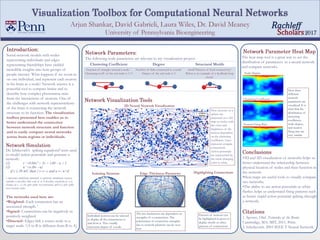
Arjun Visulaization of Computational Neural Networks
- 1. Arjun Shankar, David Gabrieli, Laura Wiles, Dr. David Meaney University of Pennsylvania Bioengineering Social network models with nodes representing individuals and edges representing friendships have yielded incredible insights into how groups of people interact. What happens if we zoom in on one individual, and represent each neuron in his brain as a node? Network science is a powerful tool to compare brains and to describe how complex phenomena arise from the interactions of neurons. One of the challenges with network representations of the brain is connecting the network structure to its function. The visualization toolbox presented here enables us to better understand the connection between network structure and function and to easily compare neural networks across brain regions or individuals. Dr. Izhikevich’s spiking equations2 were used to model action potentials and generate a network: (1) v’=0.04v2 + 5v + 140 – u + I (2) u’=a (bv - u) if v ≥ 30 mV, then { v ← c and u ← u+d v represents membrane potential, u represents membrane recovery variable, a describes time scale of u, b describes sensitivity of u to changes in v, c is the after spike reset potential, and d is after spike reset recovery value The following node parameters are relevant to my visualization project: The networks used here are: •Weighted- Each connection has an associated strength. 1 •Signed- Connections can be negatively or positively weighted. •Directed- Edges link a source node to a target node. 1(A to B is different from B to A) Clustering Coefficient Degree Structural Motifs Fraction of triangles around a node. 1 Clustering coeff. of the red node is 1/3 Number of links connected to a node1 Degree of the red node is 3 Small Patterns of local connectivity1 Below is an example of a feedback loop motif: 2017 2D Neural Network Visualization Here neurons on a sphere are projected on a 2D map as circles with the color and brightness of the neuron dependent on the clustering coefficient. Lines represent synaptic connections. Action potentials are represented by the circle changing color to white . Individual neurons can be selected to display all the connections to and from it. This visually represents degree of a node. The line thicknesses are dependent on strengths of a connections. The polarization of connection strengths due to network plasticity can be seen here. Patterns of neurons can be highlighted in green to display motifs or other patterns of connections. Edge Thickness ParameterIsolating Neurons Highlighting Connections The heat map tool is a great way to see the distribution of parameters in a neural network and compare networks. Here three different network parameters are visualized. It is clear that the distribution of clustering coefficient, node degree, and neuron firing rate are very similar. Node Degree Clustering Coefficient Neuron Firing Rate •3D and 2D visualization of networks helps us better understand the relationship between physical location of nodes and their function in the network. •Heat maps are useful tools to visually compare two networks. •The ability to see action potentials as white flashes helps us understand firing patterns such as bursts (rapid action potential spiking through a network) 1. Sporns, Olaf. Networks of the Brain. Cambridge, MA: MIT, 2011. Print. 2. Izheikevich. 2003 IEEE T Neural Network